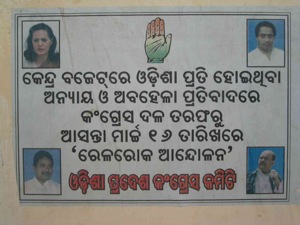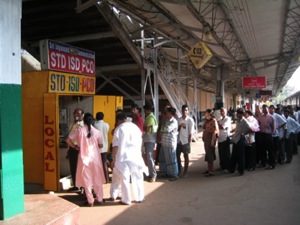

India’s "Lifeline to the Nation"
March 14-16, 2003
Our first train journey on the trip starts late at night from Mumbai's glorious Victoria Terminus. As soon as we exit the taxi, porters assail us, some even trying to lift Amy's bag right off of her shoulders. Brushing them off we make our way into the waiting room, nothing more than the station lobby where people are sprawled out everywhere on bamboo mats. Sitting there I watch as porters dressed in red with luggage piled high on their heads follow their employers through the crowds that spread out between the mighty iron columns supporting the high arched roof of this classic station.
After a humorous encounter with some beggar children we board our train, spread out our sheets and quickly settle into our bunks. Amy is up top, crammed in with both her day and travel packs. While I manage to fit my big pack beneath my bed I can barely stretch out. In spite of the gentle rocking of the train neither of us sleep well. Morning finds me awake, alone to watch out the window as the rising sun, mixed with dust and air, turns the land and sky the color of saffron. I am transfixed, content, happy to be rolling along the iron road to a place I have never been before.
********************
In our 66 days in India Amy and I spend almost 100 hours on trains, traveling close to 3000 miles. As you can imagine a good part of that time is less compelling then our first trip, but even the shortest Indian train ride provides some excitement. Our travels take us on three different classes of train, ranging from the cheapest to the second most expensive, each class with its own comforts, charms, hassles and inconveniences.
Two-tier air-conditioned (2AC) is the most expensive class we experience, consisting of six bunks per section, stacked two high. Four bunks run perpendicular to the aisle while two run parallel. The main luxuries provided are air-conditioning, sealed windows, linens, cleaner bathrooms, and a train wallah who looks after the car, keeping out most of the "color."
Our big 2AC trip is a 30-hour shot, straight up the east coast from Chennai (formerly Madras) to Kolkata (formerly Calcutta). If you add on the 10 hours it took us to get to Chennai from Mysore (we didn't stay in Chennai, only changed trains) this trip accounts for almost half of our Indian train travel. I have to admit that I was pretty excited before this journey. All the way up the coast spending a full day, a full night and then some on the same train, in the same car with the same bunks, traveling much as they did 70 years ago. Arriving in Calcutta midway through my 31st birthday just makes it that much more special. And this trip is very special.




We wake up at seven in the morning on my birthday, look out the window and find we are at the station scheduled for 4:40 am, and we are not rolling. At eight Amy ventures outside to find out what is going on. Failing to find any railway staff she talks to Sridar, a human-resources manager for ITC who is on his way north to visit his old business school. Sridar tells us there is a twelve-hour general strike called in Orissa to protest the state's take in the recently enacted federal budget, and we are only two hours into it. At least our train has stopped at a station, but Sridar says there are no other real transport options from this small town so we are stuck until someone decides to come back to work. Sridar goes on to say that last time he did this trip there was a twelve-hour strike, but that it ended five hours early, just after lunch. So, we still have some hours to kill, but Sridar helps pass the time by telling us
about corporate culture in India, his family, and some restaurants in Calcutta. We are in luck, at eleven we are rolling again.
Now that we are moving I venture along the train corridors, checking out the different classes and, as you might guess, the kitchen car, the source of the tasty snacks and less tasty meals served to the AC passengers. Like so many things in India this kitchen is like no kitchen I have seen, on a train or anywhere else. One third of the car is divided into small compartments with six fold out bunks stacked three high. These rooms double as prep areas. Inside three men are at work, one rolling out samosa wrappers while two fill them from a huge tray of spiced potatoes and onions. The sealed samosas are then carried by a runner further down the car. I follow,
Rail passengers caught in Orissa.
Rail strike. Orissa.
soon finding myself in a hallway with windows looking outside on one side and a chain-link fence on the other separating me from the hot business of the kitchen. Two giant khadi (Indian woks) filled with hot oil are propped up over the gas burners with stones, bricks and whatever else is at hand. Not exactly a stable arrangement, especially given the rough tracks of India's railways. Needless to say when the samosas were finally delivered to our seats they were piping hot and tasty. Not bad for train food.
At the other end of the spectrum are the local, Second Class Ordinary trains we take from Solapur to Bijapur to Badami to Gadag (northern Karnataka). They are cheap and crowded. The railway does not assign seats and does not limit the number of tickets they sell. Passengers crowd six across on benches meant for four Indians (three Westerners), the rest sit and stand in the aisles, on luggage racks or wherever else they find space. Given that there was barely room for Amy and I, let alone our packs, you might think the hawkers would have stayed away, but they do not even slow down. Tea, coffee, newspapers, chikoo fruit, samosas, tea, grapes, books, tea and tea are all available in quantity. "Chai, chai, chai, chai, chai. . ." chant the men as they carry huge canisters of hot, sweet milky water that they add to small cups with tea bags or instant coffee. Women in colorful dresses draped with silver jewelry hoist giant baskets of fruit on their heads. When a customer places an order the basket comes down and rests on any open surface (laps included) while the seller balances the fruit with stone weights. The hawkers push and climb through the crowds, barely making a few rupees at each sale. It is hard work climbing in and out of the trains as the hawkers make their way up an down the line, all to just eke out a living.
In addition to those selling material goods there are the sadhus, who will say a prayer for you in exchange for a few rupees. They make their way down the train car, stopping at each section to stare mysteriously at each passenger, encouraging a donation. Their hair is usually long, always scraggly, and contrasts against the dirty orange and white garb that is heavily draped over their bodies. Beads, chains and other adornments seem to hang at random. But their eyes are always clear, breaking through their chaotic attire.
Our last rail trip in India is from New Jalpaiguri to Calcutta in Sleeper Class (not our first time in Sleeper, though). At one-quarter the price of 2AC it is very attractive. Nine bunks in stacks of three, with windows that open. "Color" is very present here, with a constant parade of hawkers singing their wares as well as sadhus and other more exotic people. The food here is not cooked on the train, so like Sleeper Class as a whole, it has much more flavor then AC class. With open windows we see, hear and smell the countryside as we roll through.
On this last trip our bunkmates are a group of students who have just completed their final, secondary-school exams and are returning from a week-long vacation in the Himalayas. They are lively, bordering on rowdy, but underlying courtesy and politeness make them very tolerable, especially as the conversation wanders through a wide range of topics (my kind of people). After I move the conversation away from Iraq (everyone seems to think Americans want to talk about the war) the evening even proves enlightening.
At some point a group of what look like men in drag pass through our carriage. We had seen them on previous trips as they collected money from many of the other passengers. "Eunuchs," declare our bunkmates after they hand over a few rupees. "Giving to them brings good luck." So I ask the obvious, how do they know these are real eunuchs and not just men dressed in women's clothing. At first the only answer is uncomfortable laughter followed by: "Men wouldn't dress up as women, not even for money." Not even for a hypothetical $10,000, it turns out. Obviously these guys are in for a rude awakening if any head off to the USA for college. As it gets later Amy and I climb up to our top bunks, much smaller than 2AC. I sleep, but wake up every time someone's head brushes my feet, which stick out well into the aisle.
We awaken the next morning, 30 miles from Calcutta. Rice paddies glide past. Sunlight glows through the rising mist, softly silhouetting farmers and their water buffalo at work in the fields. Open windows bring us the smell of freshly plowed earth and of newly threshed rice drying in a factory yard. As the green fades into the dry dust of the city our last Indian train journey ends. Bodies stiff, we walk through the station and lose ourselves in Calcutta's crowded city streets.
--Z
Photographs and Text: Copyright 2002 & 2003, Zachary Maler & Amy Leffert